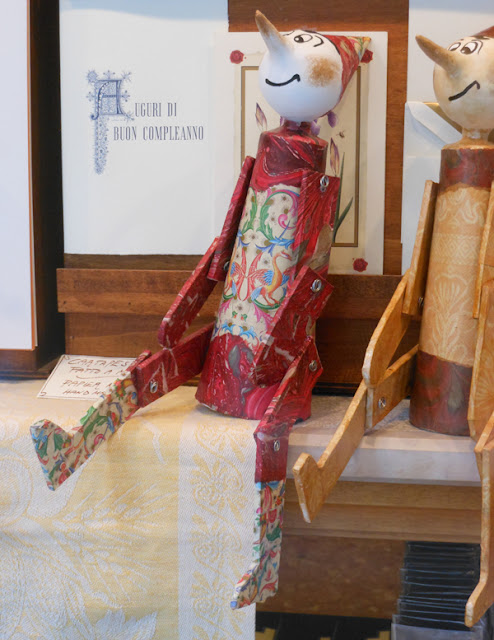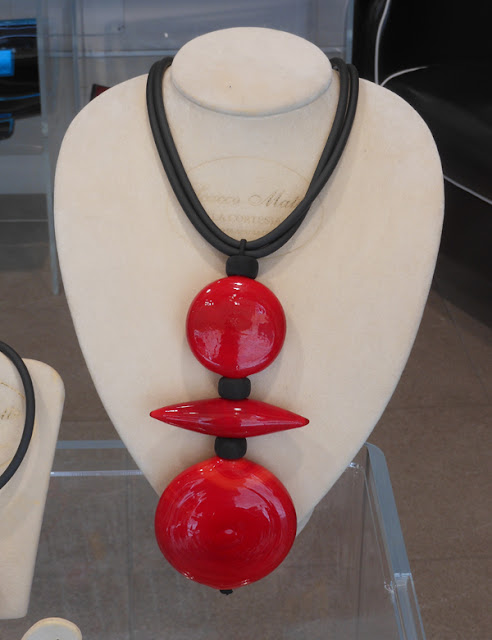A structure is needed to focus on the overwhelming details and beauty of Venice. I'm using "colors" as the structure because, when focusing on a certain color, you notice things you might never have otherwise seen. Let's start the treasure hunt!
I'm beginning with the color ROSSO
which in English, is red.
This first post's selection of photos all have to do with the water...
 |
| Red palazzo canopies on the Canal Grande. Whenever possible, everyone eats outside under umbrellas - in the campo (square), along the canal and on the many private rooftop terraces. |
 |
| The posh interior of a gondola that is waiting for passengers. Gondola design hasn't changed much since the 17th century. They are built from nearly 300 pieces of mahogany, elm, oak, lime, walnut, fir, cherry and larch. A squero, or gondola builder turns out only about four new gondolas a year. There is a shop in Venice that specializes in hand-crafting the forcola, or oarlock, that is seen in the upper left of the boat's bow. It is an intricate shape, made specifically of walnut or cherry, and crafted so that the oar can be used in eight different positions. |
 |
| It is the end of the day, and this wistful gondolier looks like he's ready for home. As touristy as it is to take an evening ride in a gondola (it costs about 100 Euros), I was literally stopped in my tracks while crossing a quiet, backwater canal. A gondola, with 2 passengers and a tenor and guitar player passed beneath me. So clear and exquisite was the music, playing acoustically off the high walls of the buildings, that I was completely spellbound. |
 |
| This boat would be the equivalent of my red, all-wheel drive Subaru Outback. Parked outside the door of its owner, it is the family's transportation and "workhorse". During the evening commute, we hear such boats whizzing by just outside the wall of our art studio, passengers shouting to one another, singing at the top of their lungs, or blasting out music that one young artist from Sweden claims is the genre called "European Grunge". |
 |
| For those familiar with Donna Leon's wonderful Venice mystery series, this is Detective Guido Brunetti's favorite cafe along the Fondamenta Zattere in the artsy district of Dorsoduro. Across the water you can see the string of islands called La Giudecca, once the main industrial section of Venice. Now, like many other places in the world, industry has moved abroad, and La Giudecca is primarily residential, with some areas being gentrified. The colossal Mulino Stucky, an historic flour mill, is now the home of a 5-star Hilton, complete with a rooftop pool! |
 |
| Well, pink is in the red family... Here, along the Zattere, in the Dorsoduro district, are moored the cruise ships that literally dwarf the city's human-scale structures. One local says, "They vomit out 7,000 tourists who walk around for a few hours, use the toilets, and get back on the ship." Turbulence caused by the ships is said to further erode foundations along the edges of the canals. Controversial? Yes, but apparently the city charges enormous docking fees... |
 |
| A fire boat - Vigile del Fuoco. Fire safety is always on the minds of Venetians because their buildings' interior structures are made of wood. The famous La Fenice opera house, Venice's oldest theater, was originally built in 1792, but burned twice - once in 1836 and again in 1996. It was rebuilt as a replica of the 1792 structure because of the design's superb acoustics. |
 |
| Men's street style in red. He sits upon the "fondamenta" which literally means foundation. These are the stone walkways that are located along the edges of some of the canals. A few are very wide, and offer rare, open spaces where people can enjoy the vistas, take a morning run, or bring their children to ride their scooters. There are no bicycles allowed in Venice - the walkways are too narrow, and there are too many bridges to cross. |
 |
| Ah, gelato! This, from the renowned Nico's (which also plays prominently in Donna Leon's mysteries), is Cioccolata & Croccante (crunchy) con Rum. It was everything they say about gelato, and more! One scoop, in a cup or cone, is 1 Euro and 30 cents. |
 |
| Coiffed in red. What more can I say? |
 |
| Here is a couple (did they coordinate that morning?) on the famous Accademia Bridge, overlooking the Canal Grande. The Canal Grande is Venice's main artery, and cuts the city in half. This bridge is one of only four bridges that cross the Canal Grande. If you want to cross where there are not bridges, you must either take a traghetto (a "commuter" gondola), or hop on a Vaporetto (water bus). The #1 "local" Vaporetto zig-zags along the canal, bringing people from one side to the other. |
 |
| Women's street style in red. |
 |
| A "red" photo having to do with water? This is from a shop that sells pipes, cigars and......beautiful water pipes! |
 |
| This red wall is in the garden of the Scuola Internazionale di Grafica where I am doing my art fellowship. The markings on the wall are a reminder of an annual occurence in Venice called "Acqua Alta" or high water. It is caused by a combination of winter tides, atmospheric pressure and wind. It has always been a part of Venetian life, but has been getting worse due to global warming. When the squares flood, temporary walkways are installed, people put on their gumboots, and panels are attached to the lower portions of doors to keep as much water out of the ground floors as possible. Italy is currently constructing a series of steel "flaps" out in the lagoon that will rise during flood season to reduce the effects of Acqua Alta. |
 |
| Venice is a densely packed city, built upon a series of islands in a lagoon. Like on the island of Manhattan, green space is a valuable commodity. Those lucky enough to have a patch guard and cherish it. Most gardens are secret, tucked away behind stone walls or intricate iron work, made all the more enticing by being glimpsed through tracery such as this. |
|
|
|
|






















































